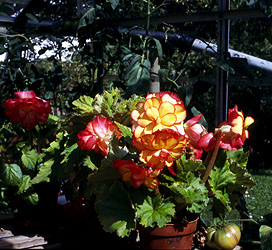Many of our most colourful and useful greenhouse and conservatory plants are Begonias. Though wandering through a botanic collection most of us might not realise just how many different plants were in fact all Begonias. For this is an immense tribe with many origins, sizes, shapes and habits, and an even more confusing collection of names and groupings. You can divide them somewhat by their root habit into fibrous and grown like Busy Lizzies or tuberous and grown like Dahlias. Even so the lists of species, synonyms and cultivars still seem endless. These include those with tiny waxy flowers in profusion that we often see blooming in summer bedding and hanging baskets once grouped as B. semperflorens, to other sorts as well known for their huge Dahlia like blooms in fireball colours, sometimes given the awful appellation of B. tuberhybrids, and there are many grown just for their beautiful leaves such as B. masoniana.
These three groupings still each contain a wide range of as many sub groups with cane stemmed, large and small rhizomatous, large and small tuberous, hirsute, winter flowering and Rexes. All a bit too much to handle. Begonias were named after a French colonial governor from Haiti, as these B. semperflorens strains were the first introduced to Europe and they were thought to come from the West Indies. Many more have been introduced from Mexico, South America, India, China and even from Socotra an island off the coast of Africa. Although some can be grown from seed for all the choicest varieties you need buy an example but then they are fairly easy to multiply with young cuttings.

Fortunately they all have a lot in common. Begonias are generally tender but not in need of great heat and so do not need a full sunny position under cover, indeed preferring one in light shade. Thus they make good fillers amongst fussier subjects and are suitable for the dimmer positions in conservatories and in bay windows and so on. Almost all are not very happy in your average border soil under cover or out. They will grow much better in a peat based ericaceous compost than a soil based one and are not at all easy in peat free mixtures. I find them happiest in sharp sand mixed with copious amounts of leaf mould.
This is because they want permanently moist compost that’s well drained so never waterlogged. Begonias sometimes suffer mildew and are occassionally attacked by the usual greenhouse pests but vine weevils are their arch enemy especially for fleshy rooted sorts- and guard your store of resting tubers as weevils will find them also. But be not alarmed, almost all Begonias are dead easy and give a truly fantastic show for little effort.


